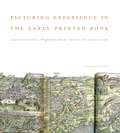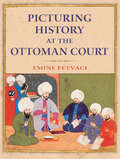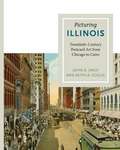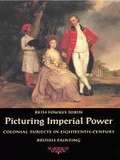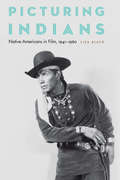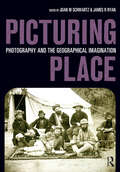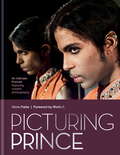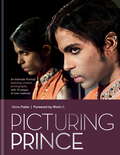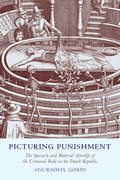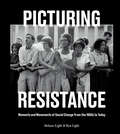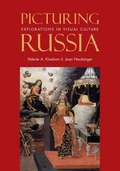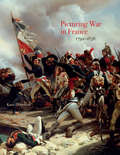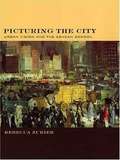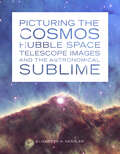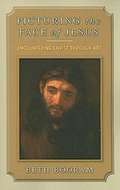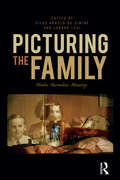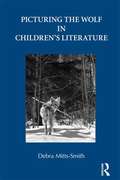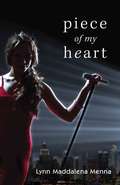- Table View
- List View
Picturing Experience in the Early Printed Book: Breydenbach’s Peregrinatio from Venice to Jerusalem
by Elizabeth RossBernhard von Breydenbach’s Peregrinatio in terram sanctam (Journey to the Holy Land), first published in 1486, is one of the seminal books of early printing and is especially renowned for the originality of its woodcuts. In Picturing Experience in the Early Printed Book, Elizabeth Ross considers the Peregrinatio from a variety of perspectives to explain its value for the cultural history of the period. Breydenbach, a high-ranking cleric in Mainz, recruited the painter Erhard Reuwich of Utrecht for a religious and artistic adventure in a political hot spot—a pilgrimage to research the peoples, places, plants, and animals of the Levant. The book they published after their return ambitiously engaged with the potential of the new print medium to give an account of their experience.The Peregrinatio also aspired to rouse readers to a new crusade against Islam by depicting a contest in the Mediterranean between the Christian bastion of the city of Venice and the region’s Muslim empires. This crusading rhetoric fit neatly with the state of the printing industry in Mainz, which largely subsisted as a tool for bishops’ consolidation of authority, including selling the pope’s plans to combat the Ottoman Empire.Taking an artist on such an enterprise was unprecedented. Reuwich set a new benchmark for technical achievement with his woodcuts, notably a panorama of Venice that folds out to 1.62 meters in length and a foldout map that stretches from Damascus to Sudan around the first topographically accurate view of Jerusalem. The conception and execution of the Peregrinatio show how and why early printed books constructed new means of visual representation from existing ones—and how the form of a printed book emerged out of the interaction of eyewitness experience and medieval scholarship, real travel and spiritual pilgrimage, curiosity and fixed belief, texts and images.
Picturing Experience in the Early Printed Book: Breydenbach’s Peregrinatio from Venice to Jerusalem
by Elizabeth RossBernhard von Breydenbach’s Peregrinatio in terram sanctam (Journey to the Holy Land), first published in 1486, is one of the seminal books of early printing and is especially renowned for the originality of its woodcuts. In Picturing Experience in the Early Printed Book, Elizabeth Ross considers the Peregrinatio from a variety of perspectives to explain its value for the cultural history of the period. Breydenbach, a high-ranking cleric in Mainz, recruited the painter Erhard Reuwich of Utrecht for a religious and artistic adventure in a political hot spot—a pilgrimage to research the peoples, places, plants, and animals of the Levant. The book they published after their return ambitiously engaged with the potential of the new print medium to give an account of their experience.The Peregrinatio also aspired to rouse readers to a new crusade against Islam by depicting a contest in the Mediterranean between the Christian bastion of the city of Venice and the region’s Muslim empires. This crusading rhetoric fit neatly with the state of the printing industry in Mainz, which largely subsisted as a tool for bishops’ consolidation of authority, including selling the pope’s plans to combat the Ottoman Empire.Taking an artist on such an enterprise was unprecedented. Reuwich set a new benchmark for technical achievement with his woodcuts, notably a panorama of Venice that folds out to 1.62 meters in length and a foldout map that stretches from Damascus to Sudan around the first topographically accurate view of Jerusalem. The conception and execution of the Peregrinatio show how and why early printed books constructed new means of visual representation from existing ones—and how the form of a printed book emerged out of the interaction of eyewitness experience and medieval scholarship, real travel and spiritual pilgrimage, curiosity and fixed belief, texts and images.
Picturing History at the Ottoman Court
by Emine Fetvaci“A comprehensive study of Ottoman illuminated histories and their readers, makers, intended meanings and political uses.” —Bulletin of the School of Oriental and African StudiesThe Ottoman court of the late sixteenth century produced an unprecedented number of sumptuously illustrated chronicles. While usually dismissed as imperial eulogies, Emine Fetvaci demonstrates that these books commented on contemporary events, promoted the political agendas of courtiers as well as the sultan, and presented their patrons and creators in ways that helped shape the perspectives of their elite audience. Picturing History at the Ottoman Court traces the simultaneous crafting of political power, the codification of a historical record, and the unfolding of cultural change.“An absolutely original work, full of good ideas and important points. Fascinating.” —Pamela Brummett, University of Tennessee“One of the most profound examples of new directions in scholarship dealing with “the book” and “the text” of the past few decades. It shows an exceptional breadth of vision.” —Walter G. Andrews, University of Washington“[Fetvaci’s] book, an exhaustive and richly illustrated study based on secondary literature and primary sources, among them some documents in the Topkapi Palace archive, will no doubt remain the standard study on the topic for many years to come.” —Bibliotheca Orientalis“A welcome addition to the work of scholars who are studying these manuscripts in relation to the context of their production. This is a handsome book.” —International Journal of Islamic Architecture“This is a book for the specialist as well as the intelligent undergraduate, as its exceptional clarity of organization and exposition makes complex and overlapping dynamics readily meaningful. The lavish illustration (102 colour plates) and the author’s interest in comparative imperial practices add to its depth.” —*Bulletin of the School of Oriental and African Studies
Picturing Identity: Contemporary American Autobiography in Image and Text
by Hertha D. WongIn this book, Hertha D. Sweet Wong examines the intersection of writing and visual art in the autobiographical work of twentieth- and twenty-first-century American writers and artists who employ a mix of written and visual forms of self-narration. Combining approaches from autobiography studies and visual studies, Wong argues that, in grappling with the breakdown of stable definitions of identity and unmediated representation, these writers-artists experiment with hybrid autobiography in image and text to break free of inherited visual-verbal regimes and revise painful histories. These works provide an interart focus for examining the possibilities of self-representation and self-narration, the boundaries of life writing, and the relationship between image and text. Wong considers eight writers-artists, including comic-book author Art Spiegelman; Faith Ringgold, known for her story quilts; and celebrated Indigenous writer Leslie Marmon Silko. Wong shows how her subjects formulate webs of intersubjectivity shaped by historical trauma, geography, race, and gender as they envision new possibilities of selfhood and fresh modes of self-narration in word and image.
Picturing Illinois: Twentieth-Century Postcard Art from Chicago to Cairo
by Keith A. Sculle John A. JakleThe American picture postcard debuted around the start of the twentieth century, creating an enthusiasm for sending and collecting postcard art that continued for decades. As a form of popular culture, scenic postcards strongly influenced how Americans conceptualized both faraway and nearby places through portrayals of landscapes, buildings, and historic sites. In this gloriously illustrated history of the picture postcard in Illinois, John A. Jakle and Keith A. Sculle study a rich and diverse set of images that chronicle what Illinoisans considered attractive, intriguing, and memorable. They also discuss how messages written on postcards reveal the sender's personal interpretation of local geography and scenery. The most popularly depicted destination was Chicago, America's great boomtown.Its portraits are especially varied, showing off its high-rise architecture, its teeming avenues, and the vitality of its marketplaces and even slaughterhouses. Postcards featuring downstate locales, however, elaborated and reinforced stereotypes that divided the state, portraying the rest of Illinois as the counterpoint to Chicago's urban bustle. Scores of cards from Springfield, Peoria, Bloomington-Normal, Urbana-Champaign, Quincy, and Vandalia emphasize wide-open prairies, modest civic edifices, and folksy charm. The sense of dichotomy between Chicago and the rest of Illinois was, of course, a substantial fallacy, since the city's very prosperity depended upon the entire state's fertile farmlands, natural resources, and small industries. Jakle and Sculle follow this dialogue between urban Chicago and rural downstate as it is illustrated on two hundred vintage postcards, observing both their common conventions and their variety. They also discuss the advances in printing technology in the early 1900s that made mass appeal possible. Providing rich historical and geographical context, Picturing Illinois: Twentieth-Century Postcard Art from Chicago to Cairo illustrates the picture postcard's significance in American popular culture and the unique ways in which Illinoisans pictured their world.
Picturing Imperial Power: Colonial Subjects in Eighteenth-Century British Painting
by Beth Fowkes TobinThis study of colonialism and art examines the intersection of visual culture and political power in late-eighteenth-century British painting. Focusing on paintings from British America, the West Indies, and India, Beth Fowkes Tobin investigates the role of art in creating and maintaining imperial ideologies and practices--as well as in resisting and complicating them. Informed by the varied perspectives of postcolonial theory, Tobin explores through close readings of colonial artwork the dynamic middle ground in which cultures meet. Linking specific colonial sites with larger patterns of imperial practice and policy, she examines paintings by William Hogarth, Benjamin West, Gilbert Stuart, Arthur William Devis, and Agostino Brunias, among others. These works include portraits of colonial officials, conversation pieces of British families and their servants, portraits of Native Americans and Anglo-Indians, and botanical illustrations produced by Calcutta artists for officials of the British Botanic Gardens. In addition to examining the strategies that colonizers employed to dominate and define their subjects, Tobin uncovers the tactics of negotiation, accommodation, and resistance that make up the colonized's response to imperial authority. By focusing on the paintings' cultural and political engagement with imperialism, she accounts for their ideological power and visual effect while arguing for their significance as agents in the colonial project. Pointing to the complexity, variety, and contradiction within colonial art, Picturing Imperial Power contributes to an understanding of colonialism as a collection of social, economic, political, and epistemological practices that were not monolithic and inevitable, but contradictory and contingent on various historical forces. It will interest students and scholars of colonialism, imperial history, postcolonial history, art history and theory, and cultural studies.
Picturing Indians: Native Americans in Film, 1941-1960
by Liza BlackStanding at the intersection of Native history, labor, and representation, Picturing Indians presents a vivid portrait of the complicated experiences of Native actors on the sets of midcentury Hollywood Westerns. This behind-the-scenes look at costuming, makeup, contract negotiations, and union disparities uncovers an all-too-familiar narrative of racism and further complicates filmmakers&’ choices to follow mainstream representations of &“Indianness.&” Liza Black offers a rare and overlooked perspective on American cinema history by giving voice to creators of movie Indians—the stylists, public relations workers, and the actors themselves. In exploring the inherent racism in sensationalizing Native culture for profit, Black also chronicles the little-known attempts of studios to generate cultural authenticity and historical accuracy in their films. She discusses the studios&’ need for actual Indians to participate in, legitimate, and populate such filmic narratives. But studios also told stories that made Indians sound less than Indian because of their skin color, clothing, and inability to do functions and tasks considered authentically Indian by non-Indians. In the ongoing territorial dispossession of Native America, Native people worked in film as an economic strategy toward survival. Consulting new primary sources, Black has crafted an interdisciplinary experience showcasing what it meant to &“play Indian&” in post–World War II Hollywood.
Picturing Place: Photography and the Geographical Imagination
by James R. Ryan Joan M. SchwartzThe advent of photography opened up new worlds to 19th century viewers, who were able to visualize themselves and the world beyond in unprecedented detail. But the emphasis on the photography's objectivity masked the subjectivity inherent in deciding what to record, from what angle and when. This text examines this inherent subjectivity. Drawing on photographs that come from personal albums, corporate archives, commercial photographers, government reports and which were produced as art, as record, as data, the work shows how the photography shaped and was shaped by geographical concerns.
Picturing Prince: An Intimate Portrait
by Steve ParkePICTURING PRINCE sees the late icon's former art director, STEVE PARKE, revealing stunning intimate photographs of the singer from his time working at Paisley Park. At least half of the images in the book are exclusively published here for the first time; most other images in the book are rare to the public eye.Alongside these remarkable images are fifty engaging, poignant and often funny written vignettes by Parke, which reveal the very human man behind the reclusive superstar: from shooting hoops to renting out movie theatres at 4am; from midnight requests for camels to meaningful conversations that shed light on Prince as a man and artist. STEVE PARKE started working with Prince in 1988, after a mutual friend showed Prince some of Steve's photorealistic paintings. He designed everything from album covers and merchandise to sets for Prince's tours and videos. Somewhere in all of this, he became Paisley Park's official art director. He began photographing Prince at the request of the star himself, and continued to do so for the next several years. The images in this book are the arresting result of this collaboration.
Picturing Prince: An Intimate Portrait
by Steve ParkePICTURING PRINCE sees the late icon's former art director, STEVE PARKE, revealing stunning intimate photographs of the singer from his time working at Paisley Park. At least half of the images in the book are exclusively published here for the first time; most other images in the book are rare to the public eye.Alongside these remarkable images are fifty engaging, poignant and often funny written vignettes by Parke, which reveal the very human man behind the reclusive superstar: from shooting hoops to renting out movie theatres at 4am; from midnight requests for camels to meaningful conversations that shed light on Prince as a man and artist. STEVE PARKE started working with Prince in 1988, after a mutual friend showed Prince some of Steve's photorealistic paintings. He designed everything from album covers and merchandise to sets for Prince's tours and videos. Somewhere in all of this, he became Paisley Park's official art director. He began photographing Prince at the request of the star himself, and continued to do so for the next several years. The images in this book are the arresting result of this collaboration.
Picturing Prince: An Intimate Portrait
by Steve ParkePICTURING PRINCE sees the late icon's former art director, STEVE PARKE, revealing stunning intimate photographs of the singer from his time working at Paisley Park. At least half of the images in the book are exclusively published here for the first time; most other images in the book are rare to the public eye.Alongside these remarkable images are fifty engaging, poignant and often funny written vignettes by Parke, which reveal the very human man behind the reclusive superstar: from shooting hoops to renting out movie theatres at 4am; from midnight requests for camels to meaningful conversations that shed light on Prince as a man and artist. STEVE PARKE started working with Prince in 1988, after a mutual friend showed Prince some of Steve's photorealistic paintings. He designed everything from album covers and merchandise to sets for Prince's tours and videos. Somewhere in all of this, he became Paisley Park's official art director. He began photographing Prince at the request of the star himself, and continued to do so for the next several years. The images in this book are the arresting result of this collaboration.
Picturing Prince: An Intimate Portrait
by Steve ParkePICTURING PRINCE sees the late icon's former art director, STEVE PARKE, revealing stunning intimate photographs of the singer from his time working at Paisley Park. At least half of the images in the book are exclusively published here for the first time; most other images in the book are rare to the public eye.Alongside these remarkable images are fifty engaging, poignant and often funny written vignettes by Parke, which reveal the very human man behind the reclusive superstar: from shooting hoops to renting out movie theatres at 4am; from midnight requests for camels to meaningful conversations that shed light on Prince as a man and artist. STEVE PARKE started working with Prince in 1988, after a mutual friend showed Prince some of Steve's photorealistic paintings. He designed everything from album covers and merchandise to sets for Prince's tours and videos. Somewhere in all of this, he became Paisley Park's official art director. He began photographing Prince at the request of the star himself, and continued to do so for the next several years. The images in this book are the arresting result of this collaboration.
Picturing Punishment: The Spectacle and Material Afterlife of the Criminal Body in the Dutch Republic
by Anuradha GobinPicturing Punishment examines representations of criminal bodies as they moved in, through, and out of publicly accessible spaces in the city during punishment rituals in the seventeenth-century Dutch Republic. Once put to death, the criminal cadaver did not come to rest. Its movement through public spaces indicated the potent afterlife of the deviant body, especially its ability to transform civic life. Focusing on material culture associated with key sites of punishment, Anuradha Gobin argues that the circulation of visual media related to criminal punishments was a particularly effective means of generating discourse and formulating public opinion, especially regarding the efficacy of civic authority. Certain types of objects related to criminal punishments served a key role in asserting republican ideals and demonstrating the ability of officials to maintain order and control. Conversely, the circulation of other types of images, such as inexpensive paintings and prints, had the potential to subvert official messages. As Gobin shows, visual culture thus facilitated a space in which potentially dissenting positions could be formulated while also bringing together seemingly disparate groups of people in a quest for new knowledge. Combining a diverse array of sources including architecture, paintings, prints, anatomical illustrations, and preserved body parts, Picturing Punishment demonstrates how the criminal corpse was reactivated, reanimated, and in many ways reintegrated into society.
Picturing Reform in Victorian Britain
by Janice CarlisleHow did Victorians, as creators and viewers of images, visualize the politics of franchise reform? This study of Victorian art and parliamentary politics, specifically in the 1840s and 1860s, answers that question by viewing the First and Second Reform Acts from the perspectives offered by Ruskin's political theories of art and Bagehot's visual theory of politics. Combining subjects and approaches characteristic of art history, political history, literary criticism, and cultural critique, Picturing Reform in Victorian Britain treats both paintings and wood engravings, particularly those published in Punch and the Illustrated London News. Carlisle analyzes unlikely pairings - a novel by Trollope and a painting by Hayter, an engraving after Leech and a high-society portrait by Landseer - to argue that such conjunctions marked both everyday life in Victorian Britain and the nature of its visual politics as it was manifested in the myriad heterogeneous and often incongruous images of illustrated journalism.
Picturing Resistance: Moments and Movements of Social Change from the 1950s to Today
by Ken Light Melanie LightA compelling photographic history of the important moments of progressive resistance--from the civil rights movement to the present--to inspire the change-makers and activists of today.A powerful commemoration of notable moments of protest, Picturing Resistance highlights the important American social justice movements of the last seven decades. Including both black-and-white and color photographs, this important record pairs iconic and unexpected images with insightful narrative captions that contextualize the meanings behind the moments. UC Berkeley Graduate School of Journalism professor Ken Light and author Melanie Light have carefully curated unconventional photographs of the most memorable moments in twentieth- and twenty-first-century protest history, offering a fresh perspective on these important occasions. In place of the iconic image of Martin Luther King, Jr. speaking at the March on Washington, Picturing Resistance conveys the feeling of pain and frustration of the time period by instead showing him moments after being arrested, restrained against a police station table. The moments captured in Picturing Resistance take the reader on a journey through decades of people-powered protest, featuring images from the front lines of the civil rights, women's, environmental, and disability rights movements, as well as contemporary movements like Black Lives Matter and March for Our Lives. Picturing Resistance will inspire revolutionary thinkers, activists, and dreamers of all stripes to celebrate the milestones of the past as we build a progressive future.
Picturing Russia: Explorations in Visual Culture
by Joan Neuberger Valerie A. KivelsonThis wide-ranging book is the first to explore the visual culture of Russia over the entire span of Russian history, from ancient Kiev to contemporary, post-Soviet society. Illustrated with more than one hundred diverse and fascinating images, the book examines the ways that Russians have represented themselves visually, understood their visual environment, and used visual images in social and political contexts.
Picturing Victorian America: Prints by the Kellogg Brothers of Hartford, Connecticut, 1830-1880
by Kate Steinway Nancy FinlayThis is the first book-length account of the pioneering and prolific Kellogg family of lithographers, active in Connecticut for over four decades. Daniel Wright Kellogg opened his print shop on Main Street in Hartford five years before Nathaniel Currier went into a similar business in New York and more than twenty-five years before Currier founded his partnership with James M. Ives, yet Daniel and his brothers Elijah and Edmund Kellogg have long been overshadowed by the Currier & Ives printmaking firm. Editor Nancy Finlay has gathered together eight essays that explore the complexity of the relationships between artists, lithographers, and print, map, and book publishers. Presenting a complete visual overview of the Kelloggs' production between 1830 and 1880, Picturing Victorian America also provides museums, libraries, and private collectors with the information needed to document the Kellogg prints in their own collections. The first comprehensive study of the Kellogg prints, this book demands reconsideration of this Connecticut family's place in the history of American graphic and visual arts.CONTRIBUTORS: Georgia B. Barnhill, Lynne Zacek Bassett, Candice C. Brashears, Nancy Finlay, Elisabeth Hodermarsky, Richard C. Malley, Sally Pierce, Michael Shortell, Kate Steinway.
Picturing War in France, 1792†“1856
by Katie HornsteinFrom the walls of the Salon to the pages of weekly newspapers, war imagery was immensely popular in postrevolutionary France. This fascinating book studies representations of contemporary conflict in the first half of the 19th century and explores how these pictures provided citizens with an imaginative stake in wars being waged in their name. As she traces the evolution of images of war from a visual form that had previously been intended for mostly elite audiences to one that was enjoyed by a much broader public over the course of the 19th century, Katie Hornstein carefully considers the influence of emergent technologies and popular media, such as lithography, photography, and panoramas, on both artistic style and public taste. With close readings and handsome reproductions in various media, from monumental battle paintings to popular prints, Picturing War in France,1792–1856 draws on contemporary art criticism, war reporting, and the burgeoning illustrated press to reveal the crucial role such images played in shaping modern understandings of conflict.
Picturing the 'Pregnant' Magdalene in Northern Art, 1430-1550: Addressing and Undressing the Sinner-Saint (Women and Gender in the Early Modern World)
by Penny Howell JollyExamining innovations in Mary Magdalene imagery in northern art 1430 to 1550, Penny Jolly explores how the saint’s widespread popularity drew upon her ability to embody oppositions and embrace a range of paradoxical roles: sinner-prostitute and saint, erotic seductress and holy prophet. Analyzing paintings by Rogier van der Weyden, Quentin Massys, and others, Jolly investigates artists’ and audiences’ responses to increasing religious tensions, expanding art markets, and changing roles for women. Using cultural ideas concerning the gendered and pregnant body, Jolly reveals how dress confirms the Magdalene’s multivalent nature. In some paintings, her gown’s opening laces betray her wantonness yet simultaneously mark her as Christ’s spiritually pregnant Bride; elsewhere ’undress’ reconfirms her erotic nature while paradoxically marking her penitence; in still other works, exotic finery expresses her sanctity while celebrating Antwerp’s textile industry. New image types arise, as when the saint appears as a lovesick musician playing a lute or as a melancholic contemplative, longing for Christ. Some depictions emphasize her intercessory role through innovative pictorial strategies that invite performative viewing or relate her to the mythological Pandora and Italian Renaissance Neoplatonism. Throughout, the Magdalene’s ambiguities destabilize readings of her imagery while engaging audiences across a broad social and religious spectrum.
Picturing the City: Urban Vision and the Ashcan School
by Rebecca ZurierPicturing the City takes a fresh look at the well-loved Ashcan School artists, a group of artists who sought to document everyday life in turn-of-the-century New York City, capturing it in realistic and unglamorized paintings and etchings of urban street scenes.
Picturing the Cosmos: Hubble Space Telescope Images and the Astronomical Sublime
by Elizabeth A. KesslerThe vivid, dramatic images of distant stars and galaxies taken by the Hubble Space Telescope have come to define how we visualize the cosmos. In their immediacy and vibrancy, photographs from the Hubble show what future generations of space travelers might see should they venture beyond our solar system. But their brilliant hues and precise details are not simply products of the telescope&’s unprecedented orbital location and technologically advanced optical system. Rather, they result from a series of deliberate decisions made by the astronomers who convert raw data from the Hubble into spectacular pictures by assigning colors, adjusting contrast, and actively composing the images, balancing the desire for an aesthetically pleasing representation with the need for a scientifically valid one.In Picturing the Cosmos, Elizabeth A. Kessler examines the Hubble&’s deep space images, highlighting the remarkable resemblance they bear to nineteenth-century paintings and photographs of the American West and their invocation of the visual language of the sublime. Drawing on art history and the history of science, as well as interviews with astronomers who work on the Hubble Heritage Project, Kessler traces the ways that the sublime, with its inherent tension between reason and imagination, not only forms the appearance of the images, but also operates on other levels. The sublime informs the dual expression—numeric and pictorial—of digital data and underpins the relevance of the frontier for a new era of exploration performed by our instruments rather than our bodies. Through their engagement with the sublime the Hubble images are a complex act of translation that encourages an experience of the universe as simultaneously beyond humanity&’s grasp and within the reach of our knowledge.Strikingly illustrated with full-color images, this book reveals the scientific, aesthetic, and cultural significance of the Hubble pictures, offering a nuanced understanding of how they shape our ideas—and dreams—about the cosmos and our places within it.
Picturing the Face of Jesus: Encountering Christ through Art
by Beth BooramFor many who identify themselves as Christians, Jesus has never become experientially personal or real. Countless others who have faithfully followed Christ confess to a spiritual dryness and lack of joy. These individuals are weary and unmoved by the plethora of information about Jesus. What they long for is an experience with Jesus.Picturing the Face of Jesus is an invitation to experience Christ more deeply. Through a rich palette of experiential media—art contemplation, gospel story-telling, and imaginative prayer—the reader is invited to picture the face of Jesus, his expressive, one-of-a-kind, human face. As a result, Jesus will become a real person with whom they candidly relate, instead of a hero they merely admire. Through this encounter, their own hearts will be transformed as they begin to reflect the face of Christ to others.
Picturing the Family: Media, Narrative, Memory
by Silke Arnold-de Simine; Joanne LealWhether pasted into an album, framed or shared on social media, the family photograph simultaneously offers a private and public insight into the identity and past of its subject. Long considered a model for understanding individual identity, the idea of the family has increasingly formed the basis for exploring collective pasts and cultural memory. Picturing the Family investigates how visual representations of the family reveal both personal and shared histories, evaluating the testimonial and social value of photography and film.Combining academic and creative, practice-based approaches, this collection of essays introduces a dialogue between scholars and artists working at the intersection between family, memory and visual media. Many of the authors are both researchers and practitioners, whose chapters engage with their own work and that of others, informed by critical frameworks. From the act of revisiting old, personal photographs to the sale of family albums through internet auction, the twelve chapters each present a different collection of photographs or artwork as case studies for understanding how these visual representations of the family perform memory and identity. Building on extensive research into family photographs and memory, the book considers the implications of new cultural forms for how the family is perceived and how we relate to the past. While focusing on the forms of visual representation, above all photographs, the authors also reflect on the contextualization and ‘remediation’ of photography in albums, films, museums and online.
Picturing the Wolf in Children's Literature (Children's Literature and Culture #69)
by Debra Mitts-SmithFrom the villainous beast of “Little Red Riding Hood” and “The Three Little Pigs,” to the nurturing wolves of Romulus and Remus and Rudyard Kipling’s The Jungle Book, the wolf has long been a part of the landscape of children’s literature. Meanwhile, since the 1960s and the popularization of scientific research on these animals, children’s books have begun to feature more nuanced views. In Picturing the Wolf in Children’s Literature, Mitts-Smith analyzes visual images of the wolf in children’s books published in Western Europe and North America from 1500 to the present. In particular, she considers how wolves are depicted in and across particular works, the values and attitudes that inform these depictions, and how the concept of the wolf has changed over time. What she discovers is that illustrations and photos in works for children impart social, cultural, and scientific information not only about wolves, but also about humans and human behavior. First encountered in childhood, picture books act as a training ground where the young learn both how to decode the “symbolic” wolf across various contexts and how to make sense of “real” wolves. Mitts-Smith studies sources including myths, legends, fables, folk and fairy tales, fractured tales, fictional stories, and nonfiction, highlighting those instances in which images play a major role, including illustrated anthologies, chapbooks, picture books, and informational books. This book will be of interest to children’s literature scholars, as well as those interested in the figure of the wolf and how it has been informed over time.
Piece of My Heart
by Lynn Maddalena MennaStill in high school, Marisol Reyes gets the chance of a lifetime to be a real singer, and she leaps at it. After all, this is the dream she held on to, all the days and nights she spent growing up on means streets of East Harlem. Marisol never gave in--no matter what her boyfriend or her best friend had to say. Who cares if only one in a hundred pretty, talented girls make it? She will be the one. In her rush to fame, Marisol tramples on the heart of her loyal best friend, and Julian, the boy she loves. But will it be worth it?One night at a private gig in the Hamptons, the little Latino girl with the big voice from East Harlem gets a severe reality check. A famous rapper who claims to be interested in her talents turns out to be interested in something else, threatening not only Marisol's dreams but her body and soul. Will the realities of the gritty New York music scene put out the stars in Marisol's eyes forever?
